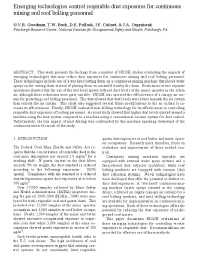Mining Publication: Emerging Technologies Control Respirable Dust Exposures for Continuous Mining and Roof Bolting Personnel
Original creation date: June 2006
This paper presents the findings from a number of NIOSH studies evaluating the impacts of emerging technologies that may reduce dust exposures for continuous mining and roof bolting personnel. These technologies include use of a wet-head cutting drum on a continuous mining machine that places water sprays on the cutting drum instead of on a manifold outby the drum. Evaluations at two separate operations showed that the use of the wet-head sprays reduced dust levels at the miner operator in the return air, although these reductions were quite variable. NIOSH also assessed the effectiveness of a canopy air curtain for protecting roof bolting personnel. The data showed that dust levels were lower beneath the air curtain than outside the air curtain. This study also suggested several future modifications to the air curtain to increase its effectiveness. Finally, NIOSH evaluated mist drilling technology for its effectiveness in controlling respirable dust exposures of bolting personnel. A recent study showed that higher dust levels existed around a machine using the mist system compared to a machine using a conventional vacuum system for dust control. Unfortunately, the true impact of mist drilling was confounded by this machine operating downwind of the continuous miner for much of the study.
Authors: GV Goodman, TW Beck, DE Pollock, JF Colinet, JA Organiscak
Conference Paper - June 2006
NIOSHTIC2 Number: 20030313
In: Mutmansky JM, Ramani RV. eds. Proceedings of the 11th U.S./North American Mine Ventilation Symposium (University Park, PA, June 5-7, 2006). London, UK: Taylor & Francis Group; :211-216
See Also
- Best Practices for Controlling Respirable Dust in Coal Mines
- Development of a canopy air curtain to reduce roof bolters’ dust exposure
- Development of a Roof Bolter Canopy Air Curtain for Respirable Dust Control
- The Effects of Water Spray Placement for Controlling Respirable Dust and Face Methane Concentrations
- Engineering Considerations and Selection Criteria for Proximity Warning Systems for Mining Operations
- Evaluation of Dust Exposures Associated with Mist Drilling Technology for Roof Bolters
- Laboratory Evaluation of a Canopy Air Curtain for Controlling Occupational Exposures of Roof Bolters
- NIOSH Research for Controlling Respirable Dust and Methane Gas on Continuous Miner Faces
- Respirable Dust Control Methods on Continuous Mining Operations
- Technology News 509 - A New Method to Clean Dust From Soiled Work Clothes
- Page last reviewed: 9/21/2012
- Page last updated: 9/21/2012
- Content source: National Institute for Occupational Safety and Health, Mining Program


 ShareCompartir
ShareCompartir
